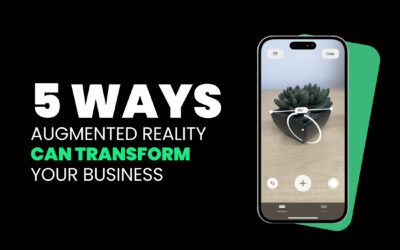Augmented reality, by definition, is any view of a physical real-world environment whose elements are augmented by virtual computer-generated imagery. This is a fairly broad definition that encompasses a lot of smaller categories.
Augmented reality is a technology that is expanding very quickly, and that has expanded further than most people realize. There have been major breakthroughs in the technology, including miniaturization and development; however there are still some weaknesses and difficulties that have yet to be solved.
When most people think of augmented reality, they tend to think of super futuristic heads-up displays that can instantly provide information on any object it sees, and help direct the user’s interactions with reality, like we have seen in the Terminator or Iron Man movies.
However, mobile technologies, digital cameras, cutting edge software developers, and the power of crowd-sourced information has helped build a new generation of augmented reality applications that are pushing the limits of the technology and creating new tools for individuals and businesses to engage each other.
This has transformed augmented reality from bulky hardware setups into small apps that run on common smartphones, home computers, and Internet applications. No longer do we need bulky goggles, awkward setups, or futuristic hardware to make it work, which has opened it up to wide-scale commercial use.
What can it do?
Despite some still existing limitations, augmented reality is actually impressively powerful, especially in mobile devices. We will discuss specific limitations in a bit more detail at the end of this article, but first the good stuff: what it can do.
Augmented Reality on Mobile Devices
Many smartphones, including the Apple iPhoneâ„¢ and many Androidâ„¢ phones, now come with a built-in GPS system and compass, which means that the phone can determine its location and know which direction you are facing. This is important because most mobile augmented reality applications rely on knowing your position, rather than on object recognition (but there are a few of those too).
This includes providing directions, providing information on things around you, and updating you when something important happens in your area. For example, if you were in a mall, an augmented reality application could help guide you to stores that had an item you wanted, update you when flash sales and discounts happen, and help you locate your friends should one get lost.
One of the more popular applications on the Droid is Google’sâ„¢ Sky Map application. Users can hold their phone up to the night sky and instantly see a label for all the stars and constellations. As the user points the phone in different directions, the image on the screen adjusts appropriately to display labels for what the user is viewing in real life.
Other similar applications have taken this technology and applied it to searching. Augmented reality browsers work by displaying search results based on proximity. As you search for the nearest pizza restaurant or hotel, these browsers will display the results in real-time digital information on top of the real world, as seen through the camera on your mobile phone. As you hold your phone up to the horizon and spin around, the overlay will show you which results appear in whichever direction you are looking.
One of the most impressive reality browser is called Layar, which allows users and developers the ability to build custom tools. As a result, users can search for hundreds of different types of things, including nearby tweets, nature pictures, service opportunities, and community events. Layar can display 3D object overlays, such as displaying the Berlin wall as it stood before 1989, or accurately placed information icons.
Augmented Reality with Webcams and Internet Applications
Another form of augmented reality that is becoming increasingly common in mobile and web applications is the use of webcams or phone cameras to overlay images onto whatever the camera is viewing.
In many cases this uses QR codes, essentially a high-tech barcode, or other visual cues in order to know how to display an object. For example, magazines, business cards, trading cards, or other materials can be printed in order to provide visual cues to the camera. Hold the card closer to the webcam and the object gets bigger; tilt or rotate the card, and the virtual object moves along with you.
This lets you virtually manipulate objects, which can be great for online shopping, games, development, and other applications. There are hundreds of examples that are currently in use, but each of them provide a new level of interactivity that gives the user the ability to “interact” with the product, rather than just see pictures or video.
Some of these applications also recognize physical gestures, which lets you control the application just by standing in view of the camera and making the appropriate gestures. For example, some applications let you virtually try on clothing from an online store. By using simple gestures, like raising your arm to the right or left, you can move to the next article of clothing, or add the current one to your shopping cart, or change the color, or any number of programmable commands.
This gives the user full control without the need to return to the computer to make selections or work with the program.
Digital live cameras have also been employed in augmented reality billboards. These billboards record what is happening on the street below, and overlay information or advertising.
One example is in Amsterdam where a prerecorded video of EMTs and medical personnel are attacked when trying to rescue an injured person. This prerecorded (and staged) video is overlaid onto a live video of people on the street. When you look at the billboard, you see what looks like a tragic event taking place. The message is that everyone needs to be aware of public servants, and help keep them safe.
This type of impact marketing reaches audiences by showing them what a situation would look like in real life. This can be for public safety situations, as described above, or for product promotion in which the audience can visualize how a certain product might look in their own home.
Custom Augmented Reality Business Integration
Companies have also started building their own augmented reality platforms for training, efficiency, and performance improvement. These projects help new and experienced employees hone their skills, learn new techniques, and respond more quickly to real-time information.
One example is BMW which is in the process of deploying its own augmented reality application for mechanics. This application is designed to improve training time, reduce errors and increase efficiency by guiding mechanics through the repair process.
This platform, which is an integration of custom hardware and software, has mechanics use specialized goggles that employ object recognition to accurately display select car parts in their real location. Not sure how to remove the radiator? This system will show you exactly which parts you need to move and remove in order to replace it. It does this by overlaying images of each part, and gives visual instructions for removing each piece.
Augmented reality applications are already being developed in many other industries, including health care and natural resource development. The increased access to real-time information gives managers and on-the-ground people, from well drillers to brain surgeons, a leg up on the competition.
What are its limitations?
The limitations mostly depend on the platform. For most businesses seeking to develop something to engage customers, matching the desired features of the application to the right platform may be a large hurdle. We have discussed some suggestions for matching a project to the right platform before, mostly for mobile and desktop applications, and it definitely applies here as well.
Currently, most smartphones depend on GPS and an internal compass for direction and location. This works in many situations, but is limiting because of its inherent inaccuracy. The GPS can tell what street you are on, and the compass can tell generally what direction you are facing, but if you wanted to include accurate overlays on objects or buildings, it would be nearly impossible without object recognition, or other visual location cues. You could get semi-close, sure, but without more powerful object recognition software, and more powerful mobile devices to run that software, there will always be very noticeable incongruities.
Fortunately, like with most technology, it is improving quickly. In a few years, near-real-time object recognition on smart phones will be a reality. Already Google’s app “Google Goggles” employs rudimentary object recognition, which can read and translate text, recognize paintings and landmarks, read barcodes among other things, but it still has trouble recognizing and differentiating many common objects. Also, even Google Goggles has a somewhat considerable delay in processing time and using its online knowledge database to make comparisons, which prevents it from being used in a practical AR experience.
Other limitations include wide-spread social adoption of the technology. Mobile devices, webcams, and other necessary technologies are fairly common, but still not everyone uses these devices, and not all those will use augmented reality applications. For now, it is mostly a novelty. But as more people engage the technology, user experience, usability, and quality will improve, which will result in better and more engaging applications.
So what is next?
As technology progresses, expect to quickly see augmented reality become increasingly standard in web and mobile applications. As hardware and software improve, augmented reality will become more mainstream, letting people visualize any product just by scanning its barcode, or even just by pure object recognition.
Integration into mobile devices is a given, but also expect to see it integrated into our social lives and as part of our daily experience. Already game developers, marketers, advertisers, manufactures, doctors and many other industries are working to develop augmented reality applications that will give them a leg up on their competition and produce better results in less time.
As always, we are always willing to take on a challenge and would love to work with you to build a market leading augmented reality product that will impress your clients and your competition. Let us know how our experienced development team can help you succeed.
Article Source: http://www.articlesbase.com/gadgets-and-gizmos-articles/what-is-augmented-reality-and-what-can-it-do-for-my-business-2364269.html





